
The effect of opioid therapy on osteoarthritis progression

The effect of opioid therapy on osteoarthritis progression
Progressive change in joint degeneration in patients with knee or hip osteoarthritis treated with fentanyl in a randomized trial
Yonsei Med J. 2014 Sep;55(5):1379-85Did you know you're eligible to earn 0.5 CME credits for reading this report? Click Here
Synopsis
200 patients with hip or knee osteoarthritis (OA) were randomized to conservative treatment with loxoprofen, tramadol/acetaminophen, or transdermal fentanyl. The purpose of this study was to compare rate of OA progression in the three treatments. Patients were treated for 12 weeks with the allocated therapy, then radiographically followed-up. The results indicated that all patients experienced a s...
To view the full content, login to your account,
or start your 30-day FREE Trial today.
FREE TRIAL
LOGIN
Forgot Password?
Explore some of our unlocked ACE Reports below!

Learn about our AI Driven
High Impact Search Feature
Our AI driven High Impact metric calculates the impact an article will have by considering both the publishing journal and the content of the article itself. Built using the latest advances in natural language processing, OE High Impact predicts an article’s future number of citations better than impact factor alone.
Continue



 LOGIN
LOGIN

Join the Conversation
Please Login or Join to leave comments.